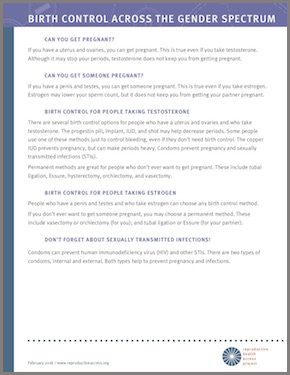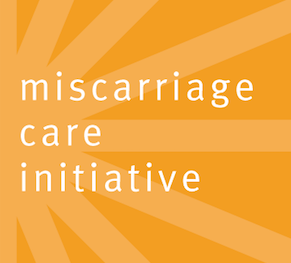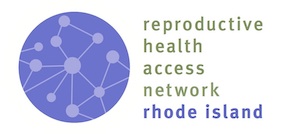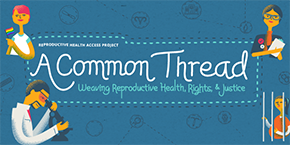Nov 06

Help Us Protect Access to Sexual and Reproductive Health Care Today!

We are excited to announce that our brand-new fact sheet, “Birth Control Across the Gender Spectrum,” is now available on our website and in our store. This patient education tool covers a comprehensive list of birth control options for folks of varied gender experiences, particularly for people taking gender-affirming hormones like testosterone. This is the first fact sheet of its kind in our resource library, and we feel that this is a critical step forward for us helping to ensure that everyone, everywhere has access to family planning services-including contraception and abortion. We recognize that LGBTQI communities often experience trauma and discrimination in health care settings, and we aimed to create a resource that provides accurate and up-to-date information while helping to reduce stigma.
Like all of RHAP’s resources, “Birth Control Across the Gender Spectrum” has been rigorously field-tested by clinicians who work with patients of varied gender experiences, as well as patients themselves. We are very grateful to the clinicians and end-users who spent time helping us to ensure that this fact sheet is comprehensive, easy-to-read, and culturally sensitive. Right now, this sheet is available in English, but we expect it to be available in Spanish and other languages soon!
RHAP’s patient education materials and clinical tools support effective communication between health care providers and patients, helping people make informed decisions about their reproductive health and care. All of our patient education materials are evidence-based, pharma-free, and field-tested. You can download them online for free at www.reproductiveaccess.org/resources, or purchase hard copies at www.reproductiveaccess.org/store.
 It’s that time of year again! RHAP is actively reaching out to identify our next Miscarriage Care Initiative (MCI) participant. The MCI is an effort by RHAP to expand access to evidence-based, patient-centered care for early pregnancy loss in primary care settings. Our vision is to support primary care clinicians and clinic administrators to integrate all three forms of miscarriage management – expectant, medication, and aspiration management – into their clinical practice.
It’s that time of year again! RHAP is actively reaching out to identify our next Miscarriage Care Initiative (MCI) participant. The MCI is an effort by RHAP to expand access to evidence-based, patient-centered care for early pregnancy loss in primary care settings. Our vision is to support primary care clinicians and clinic administrators to integrate all three forms of miscarriage management – expectant, medication, and aspiration management – into their clinical practice.
Through the Miscarriage Care Initiative, one organization will receive intensive support from RHAP to integrate and expand miscarriage treatment into a primary care practice site. The applicant organization will identify a “Clinical Champion,” who will be the primary point of contact and lead program implementation at the practice site. Please note that while the Clinical Champion is generally a board-certified family physician, non-physician providers may also serve as the Clinical Champion as long as there is another project leader who is trained to competency in offering manual vacuum aspiration (MVA). Unfortunately, we are unable to support training in MVA at this time.
We will accept applications through July 1, 2018. To learn more about the Miscarriage Care Initiative and to access the application, click here. If you have any questions regarding MCI or the application, please contact RHAP’s Senior Program Manager, Laura Riker at: laura@reproductiveaccess.org
 Drs. Wohler and Graham are family medicine residents in Rhode Island and members of the Rhode Island Cluster. They generously agreed to share their experience testifying for the Rhode Island Reproductive Health Care Act at the Rhode Island Capital this spring.
Drs. Wohler and Graham are family medicine residents in Rhode Island and members of the Rhode Island Cluster. They generously agreed to share their experience testifying for the Rhode Island Reproductive Health Care Act at the Rhode Island Capital this spring.
Diana: As a family medicine resident with an interest in women’s health and reproductive rights, I had been following the course of the Reproductive Health Care Act. The Reproductive Health Care Act (RHCA) would codify the protections of the Roe v. Wade decision into Rhode Island law, protecting the right to abortion in our little state if the Roe decision were ever to be overturned on a federal level.
Last year, I testified for the first time as a physician. The audience was small; the bill was still in special committee, and I was one of only about 60 people who were advocating for or against the bill. Overall, the environment was quiet and formal, but I felt a rush sitting in front of the legislators, sharing the story of a patient of mine who I assisted to access a safe medication abortion only four months after the birth of her first child.
This year, when I heard that the RHCA was moving to the House, I was thrilled. The bill was gaining traction. I recruited several co-residents to come to the State House to make our voice heard on behalf of our patients.
Chelsea: Diana emailed me a week before the RHCA was in the House looking for volunteers. I jumped on the opportunity. Diana and I are co-residents, but also have been active in a resident-led social justice group. If she was going, I was going.
I had returned from a high-volume abortion elective the week before, and I was ready to use my voice. I woke up early the morning of the hearing to prepare my piece in support of the RHCA. As I sipped my coffee, I thought, what story should I share? What angle do I want to take? As a physician, should I take a more of an evidenced-based, factual approach? Or should I share why abortion care is important to me and my patients? I chose the latter. As a family medicine resident, I value the patient’s journey and their story. While it is not my story to tell, I think of myself more as a vessel that holds on to this sacred experience. I shared a story about providing a surgical abortion for a woman who chose to terminate her pregnancy for the safety of her own life. She was fleeing a violent relationship and knew that terminating her pregnancy was the safest route she could take. At the end of the procedure, she hugged me and told me that I saved her life. You do not hear this often as a family physician. This story reminded me how important it is that we listen to our patients. I wanted to share that women are making these tough decisions about their bodies and we have the privilege to provide them this service.
The day of the hearing started out like any other clinic day. Diana and I saw patients in the morning and had teaching that afternoon. Right after didactics, we carpooled to the Capitol building. Whatever happened that day, we knew we were doing the right thing.
Diana: When we arrived, it was a very different scene than when I had first testified. The Capitol building was full to the brim of yelling, flag-waving men and women carrying posters with pictures of fetus parts and platitudes about “The Sanctity of Life” and “Protecting the Most Vulnerable.”. The pro-choice crowd was outnumbered at least 5 to 1. I held my pink “I Support Planned Parenthood” sign and wore my name badge identifying me as a family physician, taking in the echoing noise. Several people came up to me looking up and down at my third-trimester pregnant belly and my pink sign, hissing “You should be ashamed of yourself,” or yelling slogans inches away from my face. I felt scared, then embarrassed that I felt scared, then angry that I was being made to feel this way.
Chelsea: That night some of us testified, and others were there to show support. It was a blanket of safety in an environment that evoked fear. In total, we were approximately 5 family physicians, 7 OBGYNs, and a number of providers from Planned Parenthood. When we walked into the capitol, we were met by a sea of yellow T-shirts. It happened to be the same day that there were two gun bills on the floor as well. The gun bills went before us. The yellow T-shirts had a pro-second amendment slogan on them. There were American flags flying, rolled up muscle shirts, and an air of toxic masculinity. We weaved our way through the crowd to sign up for our testimony. By now, it was almost 5pm. The Capitol was full. We were escorted to a viewing room on the second floor. None of our group brought snacks or water. We knew we were going to wait, but we did not know how long. After the sea of pro-gun supporters left, the pro-life group still remained. They outnumbered us by far. I felt fear. We were the minority. I am used to being surrounded by my pro-choice colleagues, but that night, we were the few. I felt vulnerable.
Diana: I was finally called to testify at 9pm. I shared my piece, focusing on the safety and social justice aspects of the access to legal abortions. I sighed with relief after I heard “Thank you for your testimony, doctor.”
Chelsea: By 9:30pm, I finally got called to testify. I had just watched Diana share her powerful testimony. I felt relieved and knew that I was doing the right thing. If she was up there, I could get up there too. I shared my piece on why I was supporting reproductive rights and that if we listen to women, we know that we are doing the right thing. After my testimony, I found my OBGYN and family medicine colleagues and left the building. I had just outed myself as an abortion provider and did not feel comfortable being surrounded by hundreds of emotionally charged pro-life supporters. Our small pro-choice group ended the night over a shared meal to debrief and reflect on how important it is to be an advocate even when we feel threatened.
Diana: I left right away-I had to get home and get some sleep before the next day’s shift- and was walking alone through the entrance to the Capitol when I heard a loud “Hey!” I turned, alarmed, to see a very large and stern-looking security guard.
“You just spoke. At the testimony,” he said flatly.
“…Yes, I did.”
“Yeah. You did good. Thank you,” he barked.
I was touched, surprised, and relieved. Mostly, I was glad to have a positive last moment that night at the Capitol building. Testifying for abortion rights is never easy, but I am always glad when I do, and I and look forward to continuing to do so for as long as is necessary.
 The early hours of June 28, 1969, became a turning point for the LGBT community in the streets of New York City’s West Village. What initially began as a raid by the NYPD of the infamous mafia-run bar, Stonewall Inn, became a series of violent protests that lasted for six days. It quickly turned into the foundation of the modern-day LGBT movement.
The early hours of June 28, 1969, became a turning point for the LGBT community in the streets of New York City’s West Village. What initially began as a raid by the NYPD of the infamous mafia-run bar, Stonewall Inn, became a series of violent protests that lasted for six days. It quickly turned into the foundation of the modern-day LGBT movement.
Pride Month, held every June, is meant to commemorate the Stonewall Riots and honor members of the LGBT community who have been mobilizing towards liberation. And like previous months, The Reproductive Health Access Project will be profiling individuals as a part of our year-long educational campaign, “A Common Thread: Weaving Reproductive Health, Rights and Justice,” that challenges and deconstructs the reproductive health narrative by exposing unsung heroes and visible change makers who have dedicated their lives to the movement.
You will be able to learn more about one of the mothers of the movement, the transgender activist Marsha P. Johnson (fellow Stonewall icon and transgender activist Sylvia Rivera was profiled on our blog for Hispanic Heritage Month in 2017). We will also feature Nadine Smith, the LGBT community organizer, lobbyist, and executive director of Equality Florida, the state’s largest organization dedicated to ending discrimination based on sexual orientation and gender identity. All of our profiles will be featured on our blog and social media every Friday throughout the month of June, so stay tuned!
Your gift allows us to train and support health care providers across the United States so they can offer patients compassionate and comprehensive care.
Nov 06
